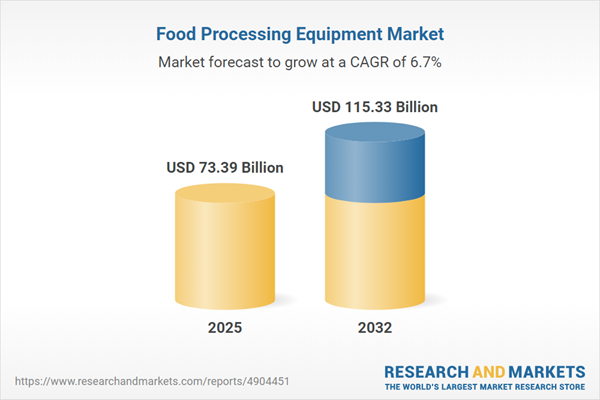Speak directly to the analyst to clarify any post sales queries you may have.
The food processing equipment market is evolving rapidly, shaped by rising consumer expectations, regulatory rigor, and technological advancements. Senior decision-makers are redefining production strategies to increase throughput, ensure compliance, and build sustainable long-term value across supply chains.
Market Snapshot: Food Processing Equipment Market Growth and Trends
The Food Processing Equipment Market grew from USD 68.70 billion in 2024 to USD 73.39 billion in 2025. It is expected to continue expanding at a CAGR of 6.69%, reaching USD 115.33 billion by 2032. Continuous advancement in process automation and integration of digital technologies are accelerating adoption across multiple industry segments.
Scope & Segmentation of the Food Processing Equipment Market
- Equipment Types: Blanching and Cooking, Cutting and Slicing, Drying and Dehydration, Grinding and Milling, Mixing and Kneading, Packaging, Sorting and Grading
- Mode of Operation: Automatic, Semi-Automatic, Manual
- Capacity: Large Scale, Medium Scale, Small Scale
- Technology: Cryogenic (Cryogenic Grinding, Frozen Processing Equipment), Thermal (Frying, Pasteurization, Sterilization Equipment)
- Applications: Bakery and Confectionery, Beverage Processing, Dairy Processing, Fruit and Vegetable Processing, Meat Processing
- End Users: Food and Beverage Manufacturers, Foodservice Operators, Retail and Supermarkets
- Geographic Regions: Americas (United States, Canada, Mexico, Brazil, Argentina, Chile, Colombia, Peru), Europe Middle East & Africa (UK, Germany, France, Russia, Italy, Spain, Netherlands, Sweden, Poland, Switzerland, UAE, Saudi Arabia, Qatar, Turkey, Israel, South Africa, Nigeria, Egypt, Kenya), Asia-Pacific (China, India, Japan, Australia, South Korea, Indonesia, Thailand, Malaysia, Singapore, Taiwan)
- Major Companies: Tetra Pak International S.A., GEA Group Aktiengesellschaft, Bühler AG, Alfa Laval AB, SPX FLOW, Inc., Marel hf., JBT Corporation, Pentair plc, Heat and Control Pty Ltd, Provisur Technologies, Inc.
Key Takeaways: Food Processing Equipment Ecosystem
- Adoption of modular and automated production lines enables processors to efficiently manage diverse product portfolios, while supporting flexibility and waste reduction.
- Integration of real-time monitoring, AI-driven analytics, and robotics optimizes throughput, maintenance, and quality assurance, minimizing reliance on manual operations.
- Sustainability commitments have increased demand for energy-recovery systems, water-efficient cleaning, and equipment that aligns with stricter regulatory and environmental standards.
- Emerging requirements for traceability and hygiene drive uptake of blockchain-enabled tracking and more advanced cleaning protocols, particularly in segments with high food safety scrutiny.
- Strategic investments now prioritize equipment flexibility, scalability, and technology transfer, especially in rapidly developing markets and among multinational processors seeking market agility.
Tariff Impact and Strategic Adjustments
Implementation of United States tariffs on key components has prompted manufacturers to revisit sourcing strategies and reevaluate design dependencies on imported materials. As procurement costs rise and lead times fluctuate, companies are diversifying suppliers, negotiating long-term contracts, and pursuing nearshoring to maintain production continuity and responsiveness. Design optimization and supply chain agility are becoming central strategies for margin preservation and service reliability.
Methodology & Data Sources
This report is developed through a rigorous methodology that combines detailed secondary research, including industry publications and regulatory filings, with primary interviews of engineers, procurement experts, and executives globally. All insights are validated through iterative triangulation of quantitative benchmarks and qualitative feedback, ensuring reliability and practical relevance for strategic stakeholders.
Why This Report Matters: Outcomes for Senior Decision-Makers
- Enables informed strategic planning by providing actionable insight into technology trends, regulatory shifts, and market segmentation.
- Supports risk mitigation and investment prioritization through thorough analysis of supply chain disruptions and sustainability imperatives.
- Delivers clarity for equipment selection, supplier evaluation, and operational scale-up in fast-changing industry environments.
Conclusion
The food processing equipment industry is at a dynamic inflection point, with digitalization, sustainability, and strategic sourcing increasingly shaping success. This analysis equips stakeholders with a comprehensive view of evolving market forces and proven best practices for future growth.
Additional Product Information:
- Purchase of this report includes 1 year online access with quarterly updates.
- This report can be updated on request. Please contact our Customer Experience team using the Ask a Question widget on our website.
Table of Contents
3. Executive Summary
4. Market Overview
7. Cumulative Impact of Artificial Intelligence 2025
Companies Mentioned
The companies profiled in this Food Processing Equipment market report include:- Tetra Pak International S.A.
- GEA Group Aktiengesellschaft
- Bühler AG
- Alfa Laval AB
- SPX FLOW, Inc.
- Marel hf.
- JBT Corporation
- Pentair plc
- Heat and Control Pty Ltd
- Provisur Technologies, Inc.
Table Information
| Report Attribute | Details |
|---|---|
| No. of Pages | 183 |
| Published | October 2025 |
| Forecast Period | 2025 - 2032 |
| Estimated Market Value ( USD | $ 73.39 Billion |
| Forecasted Market Value ( USD | $ 115.33 Billion |
| Compound Annual Growth Rate | 6.6% |
| Regions Covered | Global |
| No. of Companies Mentioned | 11 |









